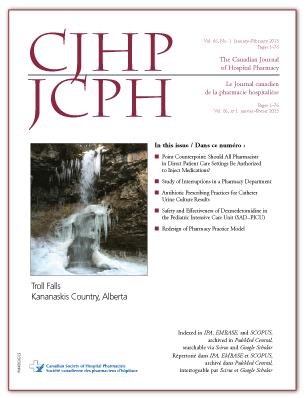Safety and Effectiveness of Dexmedetomidine in the Pediatric Intensive Care Unit (SAD–PICU)
DOI:
https://doi.org/10.4212/cjhp.v66i1.1208Keywords:
dexmedetomidine, critical care, children, sedation, dexmédétomidine, soins intensifs, enfants, sédationAbstract
ABSTRACT
Background: Critically ill children require sedation for comfort and to facilitate mechanical ventilation and interventions. Dexmedetomidine is a newer sedative with little safety data in pediatrics, particularly for therapy lasting longer than 48 h.
Objective: To quantify the frequency of adverse events and withdrawal syndromes associated with dexmedetomidine and to describe the use of this drug for continuous sedation in critically ill children.
Methods: In this retrospective study of patients who received dexmedetomidine for sedation in the pediatric intensive care unit, adverse events were assessed with the Naranjo scale to determine the likelihood of association with dexmedetomidine. Interventions in response to adverse events were also recorded.
Results: One hundred and forty-four patients (median age 34 months, range 0 – 17.7 years) who underwent a total of 153 treatment courses were included. The mean infusion rate of dexmedetomidine was 0.42 μg/kg per hour (standard deviation 0.17 μg/kg per hour, range 0.05–2 μg/kg per hour). The median duration of therapy was 20.50 h (range 0.75–854.75 h), and 70 infusions (46%) lasted more than 24 h. At least one adverse event was observed in 115 (75%) of the treatment courses. Hypotension (81 [53%]) and bradycardia (38 [25%]) were the most common adverse events and were deemed “probably” attributable to dexmedetomidine in 17 (11%) and 9 (6%) of the treatment courses, respectively. In 55 of the 66 treatment courses with infusions lasting longer than 24 h for which post-infusion data were available, at least one withdrawal symptom was observed; agitation (41 [62%]) and hypertension (22 [33%]) were the most common withdrawal symptoms.
Conclusions: Dexmedetomidine was commonly administered for longer than 24 h in the authors’ institution. Dexmedetomidine was generally well tolerated; however, the majority of patients experienced withdrawal symptoms. Patients receiving dexmedetomidine for more than 24 h should be monitored for withdrawal following discontinuation, and interventions should be provided if needed. Prospective, controlled studies are needed to characterize the safety of long-term dexmedetomidine therapy in critically ill children.
RÉSUMÉ
Contexte : Les enfants gravement malades ont besoin de sédation pour les soulager et faciliter la ventilation artificielle ainsi que les interventions. La dexmédétomidine est un sédatif récent pour lequel il existe peu de données sur l’innocuité de son emploi chez les enfants, particulièrement pour un traitement de plus de 48 h.
Objectif : Quantifier la fréquence des effets indésirables et des syndromes de sevrage associés à la dexmédétomidine et décrire l’emploi de ce médicament pour la sédation continue chez les enfants gravement malades.
Méthodes : Dans le cadre de cette étude rétrospective menée chez des patients ayant reçu de la dexmédétomidine pour la sédation dans une unité de soins intensifs pédiatriques, on a évalué les effets indésirables au moyen du score de Naranjo afin de déterminer dans quelle mesure leur survenue était associée à l’emploi de la dexmédétomidine. On a également noté les interventions en réponse à un effet indésirable.
Résultats : En tout, 144 patients (âge médian de 34 mois; étendue de 0 à 17,7 ans) ayant subi un total de 153 traitements ont été inclus dans cette étude. La vitesse de perfusion moyenne de la dexmédétomidine était de 0,42 μg/kg par heure (écart type de 0,17 μg/kg par heure, étendue de 0,05 à 2 μg/kg par heure). La durée médiane du traitement était de 20,50 h (étendue de 0,75 à 854,75 h) et 70 perfusions (46 %) ont duré plus de 24 h. Au moins un effet indésirable a été observé dans 115 (75 %) des traitements. L’hypotension (81 [53 %]) et la bradycardie (38 [25 %]) étaient les effets indésirables les plus fréquents et considérées comme étant « probablement » attribuables à la dexmédétomidine respectivement dans 17 (11 %) et 9 (6 %) des traitements. Dans 55 des 66 traitements dont les perfusions ont duré plus de 24 h et pour lesquels on disposait de données post-perfusion, au moins un symptôme de sevrage a été observé; l’agitation (41 [62 %]) et l’hypertension (22 [33 %]) étaient les symptômes de sevrage les plus courants.
Conclusions : La dexmédétomidine est couramment administrée pour des périodes de plus de 24 h à l’établissement des auteurs. Elle est généralement bien tolérée; cependant, la majorité des patients éprouvent des symptômes de sevrage. L’administration de dexmédétomidine pendant plus de 24 h commande la surveillance des symptômes de sevrage après l’arrêt du traitement et les mesures appropriées doivent être prises au besoin. Des études prospectives comparatives sont nécessaires pour caractériser l’innocuité à long terme de la dexmédétomidine chez les enfants gravement malades.
Downloads
Published
Issue
Section
License
Copyright © Canadian Society of Healthcare-Systems Pharmacy.
After publication of a manuscript in the CJHP, the authors of the manuscript must obtain written permission from the CSHP (publications@cshp.ca) before reproducing any text, figures, tables, or illustrations from the work in future works of their own. If a submitted manuscript is declined for publication in the CJHP, all said rights shall revert to the authors. Please note that any forms (e.g., preprinted orders and patient intake forms) used by a specific hospital or other health care facility and included as illustrative material with a manuscript are exempt from this copyright transfer. The CJHP will require a letter from the hospital or health care facility granting permission to publish the document(s).










